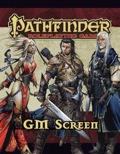Sign in to create or edit a product review. 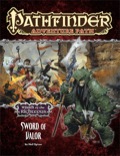
Pathfinder Adventure Path #74: Sword of Valor (Wrath of the Righteous 2 of 6) (PFRPG)Paizo Inc.Print Edition Unavailable Add PDF $19.99 Non-Mint Unavailable DISCLAIMER I've written this review as a player participating in the Wrath of the Righteous adventure path. I have not read the adventure or its backmatter, and so I cannot comment on the quality of the writing or specific mechanical elements of the adventure. Furthermore, it is quite possible that my GM has tweaked parts of the adventure to fit our group of players. I can, however, provide an account of my impressions of the adventure after a successful playthrough. Also, this review contains spoilers for Wrath of the Righteous #2: Sword of Valor. With that out of the way, let's see how this adventure performed at the gaming table. As the second installment in the Wrath of the Righteous adventure path, Wrath of the Righteous #2: Sword of Valor continues the epic story of a righteous crusade launched against the hordes of demons that threaten to undo the world. The demons have been driven from the ruined fortress city of Kenabres, and the momentous events that wrapped up the first book have all but destroyed the wardstones. All is not lost, however, because the heroes are here to save the day, fueled as they are by mythic powers. The question is, did the heroes have fun? FLUFF
The first part, the march through the Worldwound was my favorite part of the adventure. It featured everything I hoped it might - mass combat, despair, evil machinations, betrayal, all of it set against the backdrop of the Worldwound. This part of the adventure offered plenty of opportunities for some fun roleplaying, and it gave another glimpse into the wickedness of the demons and their allies. More importantly for me, though, it showcased one of the strengths of the demons in the Pathfinder RPG - their different approaches to the concept of destruction. It is easy to think of demons as one-trick ponies whose only modus operandi is SMASH KILL MAIM! That would be a mistake, though. During the heroes' march through the Worldwound, their resolve was tested as the forces of evil constantly sought to destroy the army through subtle means. Whispered suggestions and damning words of despair, infiltrations of the army camp, soldiers accusing fellow soldiers of crimes committed by agents of the Abyss. The mass combat was a mixed affair. I had fun as I took an active part in the planning and execution of the battles. Our GM did a good job describing the battles. However, if you were to ask some of my fellow players, I fear their enthusiasm might not be as profound as mine. It seems to me that the mass combat system created by Paizo lacks something in the sense that, as written, it fails to provide an immersive experience for everyone at the table. The second part of the adventure, the assault on Drezen, featured more mass combat as our army fought the city's defenders. We spent quite a bit of time debating how best to approach the liberation of Drezen, debates based on intel provided by scouts. Each section of town would grant us certain boons, so it was a matter of us to weigh those boons against the level of resistance present in each section. For me, this part of the adventure featured one of the higlights of the campaign so far. The annihilation of our army of paladins. The paladins had crushed all resistance with a single army remaining - a band of disorganized cultists. Based on our GM's description, there was no indication that this army would present a significant obstacle, and so our army took to the field. A couple of abysmal dice rolls later, both armies were destroyed. The battle showcased another issue with the mass combat rules. It's entirely too easy for a poor die roll or two to destroy an army. We turned what I felt was a low point in the campaign into the highlight it became through a great bit roleplaying. 100 men had sacrificed their lives to clear a path to the citadel for us. They had endured through several battles against a determined foe before the onslaught had become too much for even our valiant holy warriors. The impromptu memorial was one of the best roleplaying sequences I can remember enjoying in my many years playing roleplaying games. Finally our heroes were ready to assault the Citadel of Drezen itself and avenge our fallen brothers-in-arms. This third part of the adventure contained a traditional dungeon crawl, and it started with a bang. As our heroes approached the citadel, we were attacked by what I can only assume was a mythic chimera. What a fun encounter that was. Very cinematic and against an extremely tough opponent. The citadel had its share of demonic minions as well, and the first real Boss of the campaign - Staunton Vaine - was slain. All in all, the citadel was a relatively traditional dungeon, but enough demon taint was there to give it that extra flavor. I suspect that some of the encounters in the citadel were placed there by our GM, so I won't comment on those, just in case my suspicion is correct. CRUNCH
CONCLUSION

Pathfinder Adventure Path #73: The Worldwound Incursion (Wrath of the Righteous 1 of 6) (PFRPG)Paizo Inc.Print Edition Unavailable Add PDF $19.99 Non-Mint Unavailable The Invasion BeginsI've long been a fan of the concept of demonic invasions into the mortal realm, and the many opportunities such a concept adds to the gaming table. War, horror, desperation, heroism, and more. As such, it was with great glee that I saw the announcement of the Wrath of the Righteous adventure path (or The Demonblight Crusade as it was called before creative director James Jacobs asked the community to help figure out a more fitting name). I was excited. Demons. The Worldwound. The Mendevian Crusades. All three aspects of the Pathfinder campaign setting that I enjoy immensely. Since the release of Wrath of the Righteous, I've been fortunate to join an amazing group of gamers in their adventures in Mendev and the Worldwound, and our band of heroes are currently near the end of the adventure path's second book - Sword of Valor. How, then, did the first book - The Worldwound Incursion - fare at our virtual gaming table? Well, let's find out. Before I dive into the actual review, a wee spoiler warning might be in order. This review mentions specific names of characters and locations featured in the adventure. If you want to avoid possible spoilers, head on down to the CONCLUSION section for my final words on the book. Also, this review is written from the perspective of a player. I haven't read the adventure or the book's backmatter, so I can't comment on specific stat blocks or other mechanical aspects of the adventure. FLUFF
The adventure itself started beneath the city, and it was in many ways a traditional dungeoncrawl in the sense that we moved through the underground tunnels as we tried to find a way back to the surface. The trek through the underground was sprinkled with interesting encounters, and the NPCs that had been placed in the opening scene by author Amber E. Scott added color to the experience. They were interesting and had differing motivations and demeanors. I particularly enjoyed our encounters with the mongrelmen that lived beneath Kenabres, and the lore surrounding them was rich. After their first real interaction with the demonic forces via a battle against a servant of Baphomet, our heroes reached the surface, and this part of the adventure was my favorite part. Our GM did a great job describing the destruction and horror that was Kenabres, and as our heroes tried to find any surviving Mendevian crusaders, they encountered demonic vandals, madness-stricken crusaders, desperate survivors, and more. Having linked up with survivors in the inn named Defender's Heart, our heroes struck back against the Baphomite infiltrators in an assault on their safe houses, aided by clues found in the underground. As mentioned, this part was really well done. The horrror and devastation was vividly painted by our GM and the encounters fit with the general mood of the story. They made sense. The final part of the adventure was basically an assault on the demonic stronghold in the fortress city, a place called the Gray Garrison. It too was well done, I think, and the demons' desecration of the place was detailed in a manner that made me want to bash in the head of every single demon and mortal demon-worshiper we found. The encounters were somewhat challenging, but not excessively so. A couple of encounters brought one or two characters down to negative hit points. The most rewarding segment of this final part of the adventure, however, was the destruction of the city's wardstone. It was the event that added the mythic subsystem to the game, granting our characters their first mythic tier. The adventure's ending was as epic as its beginning, as the heroes received visions of times past as well as potential future enemies. CRUNCH
CONCLUSION
I recently found myself in a situation where I needed to populate the town watch in a small town for a campaign. I'd purchased Urban Dressing: The Watch a while back and I figured it might be time to put the book to the test. The book is a valuable resource in theory, containing as it does quite a few tables and some relevant stat blocks, but how well does it actually work when doing on-the-fly GMing? FLUFF
The NPCs featured in the tables offer a wide range of personalities and quirks, from the arrogant nobleman who looks down on the common folk to the paranoid specialist who believes a shadowy conspiracy lurks in the town's dark places. Not only do these NPCs provide plenty of roleplay, they are also hooks in their own right. CRUNCH
CONCLUSION
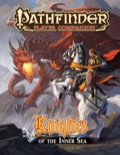
Pathfinder Player Companion: Knights of the Inner Sea (PFRPG)Paizo Inc.
Add
Print Edition
Add PDF $9.99 Non-Mint Unavailable Knights Galore!When I first learned that Paizo was working on a book about knights in the Inner Sea region, I was thrilled beyond belief. As a fan of the Dragonlance setting, I've been using knights in my games pretty much since my first game as a GM and I still do, fascinated as I am by the notion of knightly orders and the wide variety of motivations that drive these knightly orders and the individual knights within them to excel. Fast forward a few months and I've finally had a chance to actually read Knights of the Inner Sea. I'm pleased with the result and I'll tell you why. LAYOUT
This, of course, requires that the text is clear and well written, and I feel that's the case in Knights of the Inner Sea. The text is easy to understand and written in a way that certainly inspired me. I also like that each turn of the page presents a new topic relevant to knighthoods in the Inner Sea. In a product as short as the books in the Player Companion line are, you can't afford to spend too much time dwelling on a single topic. Every inch of the book has been utilized, including the inside covers. The front inside cover provides an overview of 4 knightly heritages, showcasing the differences within knightly heritages from various regions in the Inner Sea. This overview is just that. It's not a detailed essay on the history and personalities of each house, but rather a few short nuggets of information to inspire players and GMs alike to explore the notion of noble houses and knighthood in their own games. This, I think, is what Paizo does best. They provide us gamers with nuggets that allow us to add depth to our games. The back inside cover is all about mounts, focusing on the mundane sort such as horses and hounds. Once again, the information is precise, providing a brief description, a reference to a relevant stat block and book, and a game mechanic associated with the mount. Following the trend started by Varisia: Birthplace of Legends, Knights of the Inner Sea is all about making things easy for the players. From the sidebar Questions to Ask Your GM through the Rules Index to the centerfold providing a visual breakdown of a knight's armor and equipment (as well as that of his mount), Knights of the Inner Sea does its utmost to ensure that any player contemplating playing a knight has as much information as he needs to get started. I really like that. As a veteran player, I like to think I know my way around the game, but even so, the book makes my life much easier when it comes to knightly characters. For instance, before Knights of the Inner Sea, I didn't know the name of every single component of a typical knight's arms and armor. I do now. The Questions to Ask Your GM segment is just common sense. Don't create a mounted knight if your GM intends to run an all-Darklands campaign for your group, for instance. The greatest thing about the layout in the new format is that it no longer follows a set formular with specific sections that have to be in each book (such as Social, Faith, etc.). The content and the way it's laid out is adjusted to the needs of the subject matter. Of course you'll still see certain things in each installment going forward, such as the centerfold, but this seems far less forced than was the case with the old layout for the Pathfinder Player Companion Line. FLUFF
So what can you expect from the fluff in this book? Knights of the Inner Sea discusses what it means to be a knight in the Inner Sea region, covering such topics as types of knights, how religion affects a knight, and racial differences. In addition, seven specific knightly orders are presented. All of this with enough detail to help a player create a knightly character. So somewhat basic, well-written information. If you're a living Golarion encyclopedia the amount of new fluff is limited but, considering the purpose of the book, that's not a bad thing. My personal favorite part of the fluff in the book is the centerfold. I've mentioned this before but it deserves a second mention. The Anatomy of the Knight section is brilliant and it's something I'll be referencing a lot both as a player and as a GM. CRUNCH
Roles are a new feature that was premiered in Varisia: Birthplace of Legends. Some of you may not have access to that book so here's a brief description of what a role is. Basically, it's advice. Want to play a Gallowspire Warden (Knights of Ozem specializing in the patrolling of the Hungry Mountains and the prison of the Whispering Tyrant)? The Gallowspire Warden role lists options that help you build a fitting concept. Classes, archetypes, skill, feats, prestige classes, and equipment are suggested and the persona typical to Gallowspire Wardens is described. Roles are clearly meant for new players and veteran players who don't have the time and/or the desire to go through the many books published for Pathfinder (the game AND the setting). As such, it's an invaluable resource, certainly for new players for whom the prospect of browsing through thousands of pages just to find the right game mechanics can be a daunting one. The disadvantage, I think, that roles have is that, for a large portion of the player base, myself included, they fill a lot of real estate. Space that many will think could have been put to much better use either fleshing out some more fluff or presenting more new game mechanics. In the case of Knights of the Inner Sea, 4 pages have been dedicated to advice on how to build specific character concepts. I don't see myself using roles to create my characters and as such, I would have prefered something else. I realize, though, that I'm far from the only customer Paizo has to take into consideration, and roles serve their purpose quite well, I think. Squires are handled via a feat. It's basically a minor version of the Leadership feat that allows you to gain a single cohort. When you reach seventh level, the Squire feat upgrades to Leadership. Pretty cool even if the prerequisite level seems a bit off. The really cool thing, though, is the addition of squire-specific archetypes that come along with the feat. While the archetypes can certainly be taken by any character of might qualify for them, they're intended to be taken by squires. The archetypes are Combat Healer Squire (paladin), Gunner Squire (gunslinger), Herald Squire (cavalier), and Weapon Bearer Squire (fighter). All in all a fun way of handling squires in the game. Any self-respecting knight rides into battle on a war-trained steed and Knights of the Inner Sea has that aspect covered quite well, I think. The book divides mounts into two categories - Animal Mounts and Monstrous Mounts. We'll get to the animal mounts in a bit but first let's discuss the monstrous mounts. 13 monstrous mounts are featured in the book (blink dog, dragon horse, young dragon, dragonne, giant owl, griffon, hell hound, kirin, pegasus, shadow mastiff, sleipnir, unicorn, and worg). Although no new game mechanics dealing with monstrous mounts are introduced, the section does a nice job of describing how each monstrous mount might serve a knight. In addition, a page reference is given, allowing the reader to quickly look up the monster in the relevant book, and a Cohort Level is given. Very useful to any player contemplating getting a monstrous mount. Animal mounts are featured on the inside back cover of the book. In all, 5 horses (chiadmar, Dort charger, fell pony, Lastwall jasper, and Taldor jennet) and 3 non-horse mounts (Chernasado riding elk, Erutaki husky, and Qadiran dromedary) are listed on the page. Each entry contains a short description, a page reference, and a trait. Not only do we get a bunch of Golarion-specific mounts to add some flavor to our knights (as opposed to the standard Core Rulebook heavy or light horse), but each mount comes with a trait. While this trait counts against a character's total traits, whenever you switch to a new type of mount (say, from Dort charger to Lastwall jasper), you also switch traits, losing the trait you with before and gaining the trait associated with the new type of mount. I absolutely love this, as it adds a nice bit of crunch to campaigns and adventures in which mounts make sense. CONCLUSION
My only two sour grapes are roles and some of the artwork. While roles work very well for what they're supposed to do, for me personally and the kind of gamer I am, its usefulness will be limited and it'll take up a lot of real estate that I might have wanted spent differently. Again, if you're new to Pathfinder or you're one of the MANY gamers who don't think it's particularly fun to browse through book after book after book to find the fitting game mechanics, roles will be a boon. As such, it's not something that'll detract from my overall impression of the book. Roles may not be useful to me personally but for a lot of gamers, they certainly will, and they work well. The majority of the artwork in this book is quite decent. However, there are three pieces that did not sit well with me, specifically the artwork for the Hellknight, the Knight of Ozem, and the Mendevian Crusader. Artwork is a very subjective part of any roleplaying supplement, and for me those pieces did not do a good job at all visually describing typical representatives of the three orders. Other than those three pieces, the artwork in the book worked well enough, particularly the centerfold and the three panoramic pieces. All in all, a very useful book that should help a lot of players realize their knightly character concepts. It's certainly inspired me. 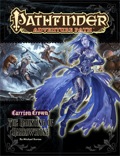
Pathfinder Adventure Path #43: The Haunting of Harrowstone (Carrion Crown 1 of 6) (PFRPG)Paizo Inc.Add PDF $19.99 Print Edition Out of print Non-Mint Unavailable This review is based on a playthrough with a group consisting of a druid, a rogue, a sorcerer/cleric, a magus, and a ranger (the ranger died and was replaced by a paladin) and the experiences we had playing the adventure. <--POTENTIAL SPOILER WARNING!--> The Carrion Crown adventure path begins with a classic ghost story, a tale of an old prison haunted by unspeakable evil. While The Haunting of Harrowstone has its issues, it's a good mix of atmosphere, story, and creepy action. Good things first: 1) The atmosphere presented in the adventure is awesome. It's gloomy and tense from the get-go and the tension only increases as the adventure progresses and the characters realize what's going on up in the old prison. The physical description of the prison itself added a lot to the atmosphere as well and the players really felt that this was a spooky ruin and that terrible things had happened there in years past. 2) The story, while not unique, is engaging and flavorful. The plot is revealed gradually and the big reveal, an encounter with the ghost of the warden's wife, was a pleasing way to reveal the final pieces of the puzzle to the players and set up the final encounters. 3) The research felt like a page right out of a Call of Cthulhu adventure which, to my players and me, is a good thing. Although the characters failed to learn everything there was to learn about the prison and its prisoners during their initial research in the temple's archives and the townhall library, the prison itself offered additional means of research. 4) The use of haunts worked very well in this adventure. Haunts make for excellent low-level encounters and the game mechanics mixed with the flavor inherent in any haunt makes for a fun way for the characters to learn more about the adventure's background while keeping them looking over their shoulders. For a ghost story set in a ruined prison, the haunt mechanic is perfect and the haunts presented in The Haunting of Harrowstone were very well written. 5) Artwork. Overall, the artwork in The Haunting of Harrowstone was top notch. Especially the half-pagers done by Craig Spearing were phenomenal and really helped me as the GM to set the mood. The Bad Things: 1) Pacing. We felt that there was an issue with the pacing of the story. As the adventure is written, the characters have roughly 30 days before the evil spirits haunting the prison escape and wreak havoc upon the town of Ravengro. It took the characters 7 days to wrap up the adventure and move on to the next adventure in Ravengro. Since the major clue to what was going on, a name written in blood, was spread out to match those 30 days, we felt that the 30 days was overkill. Half the time would have worked better, we felt, and might have added a bit more urgency to the adventure. 2) Trust. I didn't use the Trust Points system at all. I felt that what the Trust Point system was meant to achieve was just as easily achieved through simple roleplaying. To me it felt like extra book-keeping, and so I didn't bother with it. The adventure worked quite well without the system. 3) Artwork. As mentioned earlier, most of the artwork in The Haunting of Harrowstone was top notch. The exception was the Bestiary section. The artwork for the critters presented in that section didn't work for me at all. The Verdict A very good start to the Carrion Crown adventure path. There were some minor issues but those were minor and didn't take anything away from a solid ghost story filled to the rim with atmosphere and classic horror. My players felt that their characters were challenged and I felt that I'd successfully GMed a storytelling genre that, in my mind is somewhat difficult to pull off in a game like the Pathfinder RPG, namely horror. That wouldn't have happened if I didn't have a well written adventure to work with. 
Pathfinder Adventure Path #2: The Skinsaw Murders (Rise of the Runelords 2 of 6) (OGL)Paizo Inc.Add PDF $19.99 Print Edition Unavailable Non-Mint Unavailable Incredible horror story by a master writerOur group just finished playing through The Skinsaw Murders and it was an absolute blast. The adventure oozed creepy atmosphere with well written locations (high corn fields, haunted house, old clock tower, etc.) and it was a brilliant mix of horror, investigation, and action. Playing an inquisitor, I really felt that my character was useful, both in the investigative parts and the more action-packed sections of the adventure and we were all thoroughly entertained and creeped out throughout the adventure. Mr Pett has firmly cemented his posision as a top adventure writer for me and with Skinsaw Murders he gave me the best roleplaying experience I've had in a very long time, as a player at least. 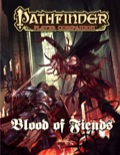
Pathfinder Player Companion: Blood of Fiends (PFRPG)Paizo Inc.Print Edition Unavailable Add PDF $9.99 Non-Mint Unavailable Excellent Start to the Blood Of X SeriesBlood of Fiends is an invaluable resource for anyone playing tiefling characters. It expands on the tiefling article featured in Council of Thieves #1: Bastards of Erebus, providing no less than 12½ pages of fluff that brings great detail to tieflings in Golarion as opposed to the 3 pages of fluff presented in the aforementioned article (not counting the article's Random Features table which is also present in Blood of Fiends). In addition to the expanded fluff, the book features a bunch of game mechanics, some of which were included in the Council of Thieves article as well. The variant tiefling heritages are more detailed in this book, providing descriptive text and awesome portraits showcasing a sample version of each heritage. One of the feats presented in the Council of Thieves article, Fiendish Heritage, has been ommitted from Blood of Fiends. So if you want a variant heritage for your tiefling character, just choose one. Don't bother with the feat. Overall this is a great player resource with lots of useful fluff AND crunch. Some of the material has been presented before, sure, but that was as an article in a primarily GM-focused product. Blood of Fiends presents all the information players need to play tiefling characters without having to borrow their GM's book. Artwork is, for the most part, phenomenal. 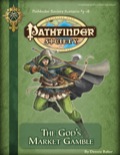
Pathfinder Society Scenario #3-18: The God's Market Gamble (PFRPG) PDFPaizo Inc.Our Price: $3.99 Add to CartVery Well Done ScenarioI've just finished running this scenario and I had a blast. The God's Market Gamble has it all - action, investigation, interesting NPCs, cool locations, and a very well crafted chase scene. The chase scene in particular was a joy to run. It really showcased the strengths of the chase mechanic featured in the GameMastery Guide and allowed me craft a hectic, action-packed chase scene through the Ascendant Court. It was very easy to work with and my players enjoyed it. As for the BBEG, she forced my players to think creatively and the inquisitor won the day through clever use of his spells (something the player never deals with, prefering to use his mundane weapons). They managed to capture her and that made for even more fun roleplaying between her, the Graycloaks, and the PCs. So yeah, very fun scenario that I would happily run again. And I'm now a huge fan of the chase mechanic. 
Pathfinder Tales: Death's HereticPaizo Inc.Print Edition Unavailable Add PDF/ePub $6.99 Non-Mint Unavailable So When does the Next Novel Come Out?James L Sutter is a brave man indeed. Not only does he venture into the Great Beyond itself with the story's hero, thus delving into matter that, in my opinion, requires a very skilled storyteller. He even goes so far as to discuss atheism in a world in which the existence of divine entities is fact. Is this bravery rewarded? Well, let's find out. As mentioned, I think that the planes are very tricky places when it comes to storytelling. With their utter disdain for the laws of physics, the outer planes are larger-than-life places where everything's possible. Terrain changes on its own accord and cities of endless wonder are created by creatures powerful beyond the comprehension of mortal minds. As such, it seems to me that it takes quite a bit of storytelling to do these wondrous places justice. And Sutter delivers. In Death's Heretic, we're treated to a delightful tour of some of the planes in the Great Beyond, including the Boneyard, Axis, the Maelstrom, and the First World and Sutter makes those places come alive to the extent that they deserve. We get so see how insignificant mortals are in the grand scheme of things. As an atheist myself, I've often wondered how atheism can exist in a world in which gods really do exist. I certainly have my own theories on the matter but Death's Heretic asks the same question through the story's main character - Salim Ghadafar. An atheist from Rahadoum, Salim is a somewhat reluctant pawn of the goddess Pharasma, acting as her inquisitor despite his own atheist beliefs. Of course, there's a good reason for this interesting master-servant relationship but I won't spoil the details. Suffice it to say that throughout this book, Salim's actions and glimpses into his past provide us with an excellent bit of insight into atheism in the world of Golarion. As with the planar material, Sutter makes it work and I finishes the book with a smile on my face as many of my ow questions on the topic of atheism had been answered. The book itself is very well written and the locations and characters we encounter are, for the most part, well fleshed out. Sutter's description of the desert nation of Thuvia was very vivid and made this GM want to run a game set in the nation. While the story's laid out as a mystery, that's not really its main strengths, I think, as I guessed the identity of the story's villain very early in the story. The fact that the heroes' adventures throughout the planes kept me reading even though the mystery wasn't much of a mystery to me is what makes this book so great. Well, that and the fact that the main character wasn't a square-jawed Rambo. Salim had issues and made mistakes. In spite of his unique situation, he was someone I could relate to. 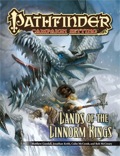
Pathfinder Campaign Setting: Lands of the Linnorm Kings (PFRPG)Paizo Inc.
Add
Print Edition
Add PDF $15.99 Non-Mint Unavailable Paizo + Vikings...Recipe for Gaming GoodnessSo I wanted to be sceptical about this product. Living in the region of this world from whence the vikings set sail to raid the world, my childhood was filled with lore of that glorious people. So when I learned that Paizo was doing a book on the Linnorm Kingdoms, I was excited. I wanted to be sceptical but that just didn't happen. It was Paizo so it had to be good. Even when the book arrived in my mail box and I started reading the thing, I tried so damn hard to be sceptical. But it didn't happen. See, like every regional sourcebook Paizo has released for the Pathfinder Campaign Setting, this one does not describe every minute detail of viking society. It doesn't reveal the inner workings of Gorum's clergy in the region nor does it give a page-long account of the average farmer's day (yes people, there are indeed farmers in the Lands of the Linnorm Kings). What the book, like every other regional sourcebook to date, does do is provide an unbelievable amount of locations, personalities, and conflicts for us GMs to take to the gaming table and give our players a good time. And it does that damn well. The book starts out with a gazetteer of the seven kingdoms and a timeline spanning from -624AR to the present date. Each entry discusses the social mindset of the kingdom and then proceeds to describe some of the most interesting locations in the kingdom. These entries are well written and filled to bursting point with adventure material. While each kingdom is a part of the Linnorm Kingdoms, they are all very different and some kingdoms aren't really kingdoms at all but rather wild regions claimed by no Linnorm King. Each kingdom presents its own set of possibilities. If you want to focus on the political tension between the Lands of the Linnorm Kings and Irrisen, then Hagreach is just the kingdom for you. If you find the struggle between tradition and progress to be fascinaing, the Ironbound Isles should keep you busy for a while. If you want to really explore the viking raiders aspect of this viking culture, look no farther than the Broken Bay. And so on and so forth. The next chapter features specific events and adventure sites that can serve as fodder for the creative GM's mind. These sites and events can all set the stage for entire campaigns set in the Linnorm Kingdoms and, in the case of sea raids, beyond. Each entry includes a stat block containing information about where the site/event is located, its master, and any notable inhabitants as well at least half a page of fluff about the entry. The third chapter in the book introduces three new mechanics to the game - reputation, effigies, and weregild. Reputation is just that. The mechanic is a representation of your character's reputation based on the adventures he's been on and the experiences he'd had during those adventures. It allows the character bo "buy" certain advantages, such as a favor, a gift or loan, or weregild payment. Effigies are used to strike fear into the hearts of enemies. Sample effigies are the standard effigy (such as heads mounted on spikes), blood eagle, the nithing pole, the tree of souls, and the wicker man. Finally the weregild mechanic represents an aspect of viking law that allows a person to pay with money for any crime he may have committed. The chapter wraps up with a description of three magic items - the banner of the ancient kings, the harp of storms, and the greatsword Rixbrand. The last chapter in the book is the bestiary. It features three monsters (the huldra, the mindslaver mold, and the mountain troll), one template (the fey animal template), four generic NPCs (the berserker cannibal, the Blackraven scout, the longboat captain, and the ulfen raider), and one very unique NPC - Fafnheir, the Father of All Linnorms. This book is a must-have for GMs running games set in Golarion. Even for games not specifically set in the Linnorm Kingdoms, there's a lot of cool information to get from this book. The new mechanics are decent enough and I could see effigies and reputation being used in non-Linnorm Kingdoms games. The bestiary is just phenomenal. I really enjoyed the generic NPCs and I hope it's something Paizo will continue doing. If you're running a game set in the Linnorm Kingdoms, those generic NPCs will come in very handy. As the title of this review implies, Treasury of the Macabre is a wonderful plug-in to any gothic horror campaign, such as the Carrion Crown adventure path published by Paizo, allowing GMs to add even more depth to their story while gifting players with fun tools with which to fight their enemies. The book is the first in what is hopefully a long series of plug-in products for the Paizo adventure paths. The idea is to expand on the adventure paths with various material, in this case magic items, that follows the theme of a particular adventure path. In the case of Treasury of the Macabre, that theme is gothic horror and the 30 items presented in the book will certainly add another layer to such a game. Each item is written with a specific theme in mind, be it cosmic horror a la H. P. Lovecraft, vampires, or ghosts as seen in classic ghost stories. This means that the magic items can be plugged into one of the six adventures in an adventure path with VERY little work on the part of the GM. The book is very well laid out. The background, font, and general layout of the book reminds me of a good ol' Paizo book. One major difference between Treasury of the Macabre (and, I assume, the rest of the series) and Paizo's books is that Treasury of the Macabre is laid out in a landscape format. I think it works well for screen use but it may present some issues for those who prefer to print their PDFs. The book makes great use of links, making it very easy to get to a specific item. The artwork in the book is very good and all color (assuming you're viewing the color version of the PDF, of course). My personal favorite is the artwork for the elder talisman. As mentioned earlier, the book contains 30 magic items divided into 4 groups: Rods (3), Weapons (2), Wondrous Items (24), and Artifacts (1). I would have liked a few more weapons and possibly a suit of armor or two. That tiny complaint aside, there's a good variety of items spread out over a large price range (600 gp - 58,000 gp). My personal favorites are the cruciform icon, the ghost shackles, the sanguinary torque, and the witchblood stylus, purely based on the flavor they bring to the game. Mechanially, all of the items I've read so far (which is nearly all of them) seem mechanically sound. Treasury of the Macabre is a must-have for any GM running a gothic horror-themed campaign and it feels very much like it's a natural extension of the Carrion Crown adventure path with 30 items just screaming to be plugged into such a game. This product is a prime example of the level of community that surrounds Paizo and their work, with 3rd party publishers expanding on what is already top-quality material. Rock on Legendary Games. The title says it all, really. This book is a gift to us GMs. With more than 700 monsters, it's a treasure trove of coolness and it'll keep players busy for a VERY long time. While I can't tell you if a monster's CMB is correct or a monster has one too many feats as I haven't read every single monster entry in detail, I can tell you that I'll be using a ton of these monsters in my own games. As an added bonus, Paizo has used the various Tomes of Horrors extensively throughout the adventure paths, and having this updated version of the Tomes means that the book becomes super relevant for those running Pathfinder modules as well. The book itself is generally well laid out. My only gripe, and Frog God Games has explained why this is so, is that there's a wee bit too much white space in several monster entries. This is a minor gripe, however, and not something that subtracts from my overall impression. The artwork is bad to awesome, all black and white. But overall a very decent collection of artwork. This screen is truly a wonderful addition to my Pathfinder RPG collection. As has been mentioned, it's very sturdy, it contains lots of useful tables, and the artwork on the front is gorgeous. While I agree with others that it would have been nice to have the actions table in the screen, I've used every table in the screen during play (with the only exception being the Treasure Values table) for various reasons so for me the tables currently on the screen have been useful to me. 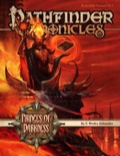
Pathfinder Chronicles: Book of the Damned—Volume 1: Princes of Darkness (PFRPG)Paizo Inc.Print Edition Unavailable Add PDF $15.99 Non-Mint Unavailable Hell is Cool Again!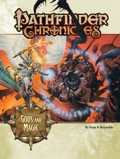
Pathfinder Chronicles: Gods & Magic (OGL)Paizo Inc.Print Edition Unavailable Add PDF $15.99 Non-Mint Unavailable 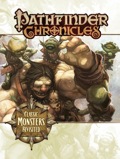
Pathfinder Chronicles: Classic Monsters Revisited (OGL)Paizo Inc.Print Edition Unavailable Add PDF $15.99 Non-Mint Unavailable Typical PaizoWith Classic Monsters Revisited, the good folks at Paizo have breathed new life into a lot of monsters that are generally considered cannon fodder in D&D games across the globe. Bugbears, gnolls, goblins, hobgoblins, kobolds, lizardfolk, minotaurs, ogres, orcs, and trolls are now so much more than cannon fodder. They're scary monsters, Funny at times (particularly the goblins), but scary. What Paizo has done is define each race's role in the game, transforming the monsters from numbers in a Monster Manual into very good storytelling tools for DMs. Want to create a "The Hills Have Eyes" adventure for your players? Use the ogres. Have an idea for a catch-the-serial-killer adventure? Read the bugbear entry. Each monster in Classic Monsters Revisited has a clearly defined role in Pathfinder and the fluff is incredibly detailed. Typical Paizo. 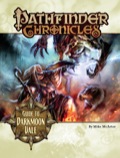
Pathfinder Chronicles: Guide to Darkmoon Vale (OGL)Paizo Inc.Print Edition Out of print Add PDF $15.99 Non-Mint Unavailable Wow!The title really says it all. This book is yet another masterpiece from Paizo. Having read Guide to Korvosa, my expectations for this book were high. I was not disappointed. Like the city sourcebook, this book is packed with goodies for players and DMs alike. I've always liked using frontier settings in my games, and now I'm even more eager to run games set in Darkmoon Vale. There were some nasty typos but I can live with that. 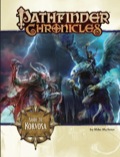
Pathfinder Chronicles: Guide to Korvosa (OGL)Paizo Inc.Print Edition Out of print Add PDF $15.99 Non-Mint Unavailable It's been said before...Guide to Korvosa is quite simply the best city sourcebook I've ever read. It's absolutely packed with incredible hooks and background material and I constantly caught myself saying "oh, I want to use this", "oh, I want to use that", and "oh that's just evil. NICE!" And that was just in the second chapter of the book. If you want a very well-written city sourcebook for your Pathfinder game or even for your homebrew campaign, look no further. Guide to Korvosa has it all. 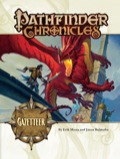
Pathfinder Chronicles: Gazetteer (OGL)Paizo Inc.Print Edition Out of print Add PDF $15.99 Non-Mint Unavailable Very Nice IntroAs has been mentioned elsewhere, this book is a great introduction to the world of Golarion. It features a ton of adventure hooks and cool information about the various nations, despite its low page count. Definitely a product I'll recommend to anyone who wants to get an idea of what Golarion has to offer. This miniature has to be the best minotaur miniature I've seen in recent times. It fits perfectly as a cleric of Sargonnas in my Dragonlance game and I'm pretty sure I can find a good use for it in other settings as well. Definitely a miniature I'd recommend. Dreamer3333 has not participated in any online campaigns. |






